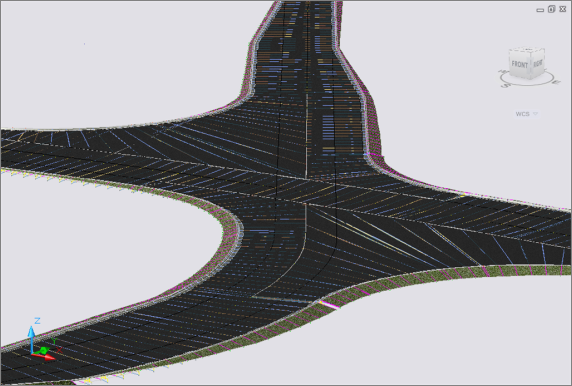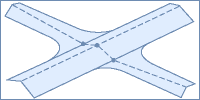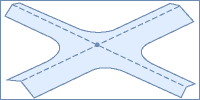Creating Intersections
You can create an intersection using the Create Intersection wizard.
Before creating an intersection object, you must have two alignments that intersect. If you want to create a three-dimensional intersection model, you must also have profiles associated with the intersecting alignments. Once you have the desired prerequisites, then you can create the intersection object using the Create Intersection wizard.

Creating a Simple 2D Intersection
When the intersection object is created, a variety of tasks can be performed automatically, including the following:
- creating offset alignments for the roads included in the intersection
- creating curb return alignments (curb returns) in the intersection area
- creating profiles for the offset alignments and curb return alignments that were created when the intersection was createdNote: An exception to this is that if you set pre-defined static alignments as offsets, it is expected that you will specify profiles too. No dynamic offset profiles will be created.
- creating new corridor regions for the existing corridors in the intersection area, or creating new corridor objects in the intersection area
- locking the profile elevations of the secondary road to the main (primary) road profile
Some of these tasks are optional. They depend on options selected in the Create Intersection wizard.
The simplest way to create a basic two-dimensional intersection object is to start with two alignments that intersect each other only once. You cannot use the Create Intersection wizard if the alignments do not intersect.
If your drawing has two intersecting alignments that meet this criteria, you can create a basic 2D intersection object using the Create Intersection wizard. Simply start the command, follow the prompts, and accept the default choices on the wizard dialog boxes.
Creating a 3D Intersection with Corridor Objects, Alignments, and Profiles
To create a 3D intersection that includes a corridor, you will need to first create the road geometry (road centerline alignments and profiles) and existing ground surface in your drawing. Once these components exist in the drawing, you can proceed with using the Create Intersection wizard. The wizard prompts you to select the location in the drawing where the two road centerline alignments intersect.
You can start with the following data combinations:
- two intersecting centerline alignments
- two intersecting centerline alignments with one or more road edge offset alignments and or their profiles
You can have profiles defined already, or not. However, if profiles are not available, then features that are associated with 3D modeling will not be available on the wizard. For example, if you begin creating an intersection object with no profiles, then the following wizard options will not be available for selection: creating offset alignment and curb return profiles, as well as the ability to create a new corridor, or to add to an existing corridor in the intersection area.
With any of the scenarios just described, you can start the Create Intersection command, select the point where the centerline alignments intersect, and proceed with creating an intersection using the Create Intersection wizard.
Intersection Road Priority
When you create an intersection object, a Priority value is assigned to the main (primary) and secondary (side) road alignments. The following table lists the value of the Priority property:
| Road (alignment) | Priority |
|---|---|
| Main (primary) road alignment | 1 |
| Secondary road alignment | 2 |
If you are creating a T-shaped (3-way) intersection, then the alignment that passes through the intersection is automatically specified as the primary road (main road). In this situation, the Priority is automatically set to a value of 1 for that alignment, and you are not prompted to specify which road is the primary road because this happens automatically.
You cannot change the priority of a road in an intersection after it has been created. However, if you want to change the priority of the alignments during the intersection creation, you can do so from the Geometry Details page of the Create Intersection wizard.
It is also important to note that typically, the secondary road (or lower priority) profile is automatically locked at the intersection location to the elevation of the main road (higher priority) main road. The profile of the main road is not modified.
Intersection Grading Options
The Intersection Corridor Type property identifies the type of grading that will be applied to roads in an intersection object: Primary Road Crown Maintained or All Crowns Maintained. You must specify this type when you create the intersection, on the General page of the Create Intersection wizard.
For existing intersections, the intersection corridor type is displayed on the Intersection Details tab of the Intersection Properties dialog box, in the Intersection Quadrants section. You can set the creation default for this option in the Edit Command Settings - CreateIntersection dialog box.
Once the intersection is created, you cannot change the value of the Intersection Corridor Type property. If you do want to change this option after the intersection object is created, you must delete the intersection object, and create a new one with the desired Intersection Corridor Type.
Primary Road Crown Maintained
In this type of intersection, the crown of the primary road is maintained, while the crown (profile) of the secondary road is adjusted to match the edge of the primary road and the intersection point. The crown (profile and edges) of the primary road are not affected.
The following conceptual graphic is displayed on the wizard dialog when you select this option:

This represents how the grading occurs for the intersection object.
All Crowns Maintained
In this type of intersection, the profile of the side road is adjusted to match the main road elevation at the intersection point. The main road profile is not affected. The edges are blended together along the curb returns (via the curb return profiles).
The following conceptual graphic is displayed on the wizard dialog when you select this option:

Note: Once an intersection object is created, you cannot change the value of the intersection Corridor Type property.
Intersection Object Considerations
It is important to understand the following before you begin creating intersections:
- Using the Create Intersection wizard, you can create an intersection object that contains up to four quadrants.
- If the default intersection assembly mapping and target assignments does not meet your design requirements, you can create the intersection using these components, and then edit the intersection regions manually to satisfy your design requirements.
- If you create an intersection, and then manually edit the intersection corridor regions, those changes will be overwritten if the intersection is regenerated (by clicking Recreate Corridor Regions on the Intersection tab) or by rebuilding the intersection.
- When creating an intersection, targeting (both horizontally and vertically) is done automatically. If you want to change targets, you must manually modify the intersection corridor region(s) using the Corridor Properties dialog box.
- Typically, when an intersection object is created, the following objects are automatically added to the current drawing: intersection object, corridor(s), assemblies, subassemblies, offset alignments, and curb return alignments. However, assemblies, subassemblies, corridors, and profiles are only added if the appropriate options are selected.

0 Comments:
Post a Comment
Subscribe to Post Comments [Atom]
<< Home